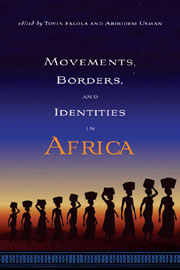Book contents
- Frontmatter
- contents
- Preface
- Introduction: Migrations in African History: An Introduction
- PART A State Formation and Migration Crossroads
- PART B Movements and Identities
- 6 Squatting and Settlement Making in Mamelodi, South Africa
- 7 “Scattering Time”: Anticolonial Resistance and Migration among the Jo-Ugenya of Kenya toward the End of the Nineteenth Century
- 8 Traders, Slaves, and Soldiers: The Hausa Diaspora in Ghana (Gold Coast and Asante) in the Nineteenth and Early Twentieth Centuries
- 9 Ethnic Identities and the Culture of Modernity in a Frontier Region: The Gokwe District of Northwestern Zimbabwe, 1963–79
- 10 Displacement, Migration, and the Curse of Borders in Francophone West Africa
- 11 Shifting Identities among Nigerian Yoruba in Dahomey and the Republic of Benin (1940s–2004)
- 12 Identity, “Foreign-ness,” and the Dilemma of Immigrants at the Coast of Kenya: Interrogating the Myth of “Black Arabs” among Kenyan Africans
- 13 Labor Market Constraints and Competition in Colonial Africa: Migrant Workers, Population, and Agricultural Production in Upper Volta, 1920–32
- List of Contributors
- Index
6 - Squatting and Settlement Making in Mamelodi, South Africa
from PART B - Movements and Identities
Published online by Cambridge University Press: 12 September 2012
- Frontmatter
- contents
- Preface
- Introduction: Migrations in African History: An Introduction
- PART A State Formation and Migration Crossroads
- PART B Movements and Identities
- 6 Squatting and Settlement Making in Mamelodi, South Africa
- 7 “Scattering Time”: Anticolonial Resistance and Migration among the Jo-Ugenya of Kenya toward the End of the Nineteenth Century
- 8 Traders, Slaves, and Soldiers: The Hausa Diaspora in Ghana (Gold Coast and Asante) in the Nineteenth and Early Twentieth Centuries
- 9 Ethnic Identities and the Culture of Modernity in a Frontier Region: The Gokwe District of Northwestern Zimbabwe, 1963–79
- 10 Displacement, Migration, and the Curse of Borders in Francophone West Africa
- 11 Shifting Identities among Nigerian Yoruba in Dahomey and the Republic of Benin (1940s–2004)
- 12 Identity, “Foreign-ness,” and the Dilemma of Immigrants at the Coast of Kenya: Interrogating the Myth of “Black Arabs” among Kenyan Africans
- 13 Labor Market Constraints and Competition in Colonial Africa: Migrant Workers, Population, and Agricultural Production in Upper Volta, 1920–32
- List of Contributors
- Index
Summary
Introduction
South Africa's constitution grants all its citizens the right to decent housing. But the end of apartheid did not stop some of the most visible expressions of segregation—shantytowns. In fact, the explosive growth of illegal squatter settlements on the peripheries of South African cities seems irreversible. Authorities react to the inevitable socioeconomic stress and unhealthy living conditions by building hundreds of thousands of small, identical, freestanding, subsidized houses. This is a questionable policy, due to the costs and sheer numbers of buildings involved, and because such Western-style suburbanism generally perpetuates urban sprawl, as well as social and economic fragmentation. Environmentally, economically, and socially sustainable strategies must arguably be informed by, and possibly aligned with, data on the dynamics of migration and the consequent patterns of shantytowns. The purpose of this chapter is to report on a study carried out to investigate the impact of migration—the fact that all residents are from somewhere else—on the form and function of an informal settlement, using an illegal shantytown in Mamelodi, South Africa, as a case study. It hopes to offer a tentative theory of settlement by exploring the relationships between (1) the demographic profiles of migrant households, including their origins and expectations; (2) the form of a squatter settlement; and (3) the way such a settlement actually functions as a setting for social and economic activities. It is well known that a shantytown, like all built environments, both shapes and responds to behavioral patterns, but when the study was initiated, it was not clear whether the shantytown's form and function were the direct and inevitable manifestations of existential realities—culturally value-free responses to poverty, marginalization, and lack of resources—or manifestations of an indigenous system of knowledge and consequently the expression of an intrinsic African urbanism.
- Type
- Chapter
- Information
- Movements, Borders, and Identities in Africa , pp. 153 - 165Publisher: Boydell & BrewerPrint publication year: 2009



